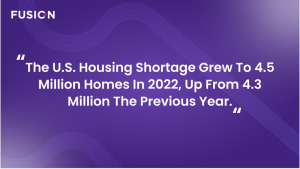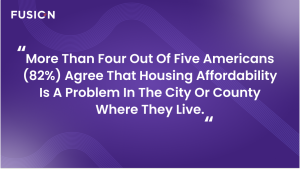Blogs| Policies to Solve the Affordable Housing Crisis
Written by

Priya Gupta
Published
Jul 4, 2025
Topics
Affordable Housing

The United States is facing an affordable housing crisis, and it’s not a distant threat. It’s here now, affecting cities, suburbs, and rural areas alike. According to the Center on Budget and Policy Priorities (CBPP), nearly 10 million low-income renter households spend over half their income on rent. That’s not just unaffordable; it’s unsustainable.
This shortage has grown more severe due to rising construction costs, outdated zoning laws, and a population growth rate that’s outpacing housing development. As home prices and rents continue to increase, more families are being pushed into precarious living situations or out of housing altogether.
Some lawmakers have deflected blame onto immigration or market forces. But those distractions delay real progress. The truth is that policy is the lever that can fix this. Smart, long-term reforms that make building, accessing, and preserving affordable homes easier are the way forward.
In this guide, we break down how the housing crisis developed, what Americans think about it, and what policies are actually helping.
Whether you’re in government, real estate, advocacy, or just trying to keep up with the rent, this is your guide for what works, what doesn’t, and what’s next in affordable housing policy.
Several interrelated factors contribute to the U.S. housing shortage. It’s not only one broken system; it’s many stacked together.
Since the 1980s, new housing construction hasn’t kept up with demand. The shortfall now exceeds 4.5 million homes. Competition for limited units drives up prices and rent as more people flock to urban and suburban job centers.
Zoning codes in many communities restrict multi-family housing or enforce lot and parking requirements that make affordable development nearly impossible. Even when there’s land and developer interest, the rules say no.
Costs for materials, labor, and land have surged. Add regulatory delays and permitting fees, and affordable projects quickly become financially unviable, especially for developers operating on tight margins.
Many older affordable units are disappearing. Some are converted to market-rate housing, others deteriorate from lack of upkeep, and some exit programs like LIHTC after their affordability terms expire. Without preservation policies, we’re losing units faster than we can build new ones.
Housing isn’t just a policy issue; it’s deeply personal. According to a recent NAHB survey, more than three in four Americans say affordability is a major concern. The worry cuts across age, income, and political lines.
People aren’t just stressed about numbers. They’re choosing between rent and essentials. They’re delaying families, postponing homeownership, or moving back in with relatives. Seniors face impossible decisions between medication and rent.
And voters are paying attention. Housing has become a leading issue in local elections. People want solutions, and they hold leaders accountable. That public pressure is building momentum for change.

There’s no single fix for the affordable housing shortage, but there are proven policies that can help. Here’s what’s working across the country and where we need to go further.
The Low-Income Housing Tax Credit (LIHTC) is the most successful federal program for creating affordable rental housing. Since 1986, it’s helped build or preserve over 3 million homes. However, its impact is limited by outdated caps, financing gaps, and affordability timelines that expire too soon.
What’s needed: Increase the annual allocation of tax credits, modernize the formula to reflect current housing needs, and extend affordability periods to 30+ years. Preservation must be prioritized alongside new development.
Programs like Section 8 vouchers help low-income renters afford homes in the private market. They reduce homelessness, improve stability, and give families more choices. But right now, only 1 in 4 eligible households actually gets help.
What’s needed: Expand funding to cover more families, streamline application processes, and incentivize more landlords to accept vouchers, especially in high-opportunity areas.
Zoning laws often stand in the way of building affordable housing. Minimum lot sizes, single-family-only zoning, and parking requirements make development costly or impossible—especially in high-demand neighborhoods.
What’s needed: Local governments should legalize ADUs, duplexes, and multi-family buildings, especially near transit and job centers. States like Oregon and cities like Minneapolis are already leading the way.
The private sector plays a big role, but only if the math makes sense. Rising land and construction costs often make affordable housing financially unviable without public support.
What’s needed: Offer tax incentives, low-interest loans, and fast-track permitting for developers building below-market units. At the same time, incentives should be tied to long-term affordability requirements so the benefit lasts.
Some of the most promising solutions come from collaboration between governments, nonprofits, and private developers. Bipartisan support has already made progress, such as through the Affordable Housing Credit Improvement Act.
What’s needed: Double down on federal-state-local partnerships that share risks and rewards. And keep pushing for bipartisan housing bills that align capital, land, and regulatory resources.
Each of these strategies plays a role. Together, they form a practical blueprint to increase supply, expand access, and stabilize affordability for the long term.
Even with great programs, progress lags because of what’s in the way:
Local pushback—often driven by NIMBY attitudes—slows or blocks needed changes, even when states lead the charge.
Programs like LIHTC and Section 8 are proven but under-resourced. Annual caps and political gridlock limit their reach.
Permitting, zoning approvals, and compliance hurdles delay affordable housing projects, sometimes by years.
Political timelines are short. Housing needs long-term investment, consistency, and commitment across election cycles.
Even the best policy won’t deliver the scale we need without addressing these blockers.
We know what’s broken and what works. Now, it’s about scaling smart policies across all levels of government.

This crisis is real. But it’s also solvable.
We have the tools. We have public support. What we need is urgency and commitment.
Solving affordable housing shortages means more than economic policy. It means giving people the chance to live where they work, raise families in stable homes, and retire with dignity.
It’s time to stop asking if the crisis can be solved and start solving it.